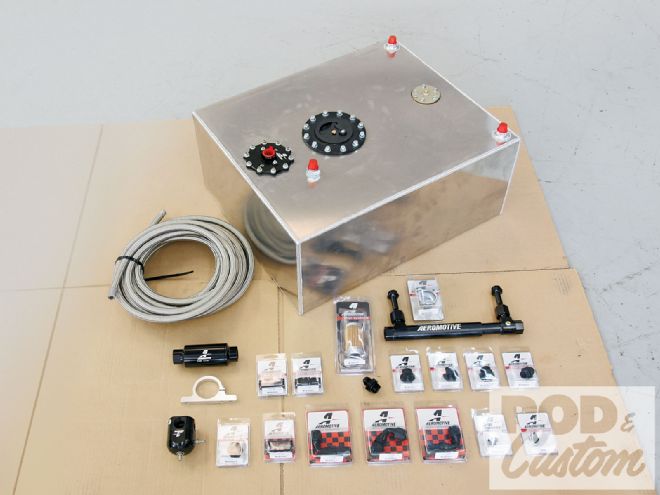
OK, so you've looked at the pictures and are wondering why I have what looks like a race car fuel system in my custom. And it's a valid point, as the Aeromotive tank, filter, and fuel log sure look like race parts, and indeed can be found on many race cars. Aeromotive is a major supplier of fuel system components for many drag race teams, as well as OE suppliers for the current Cobra Jet Mustang.
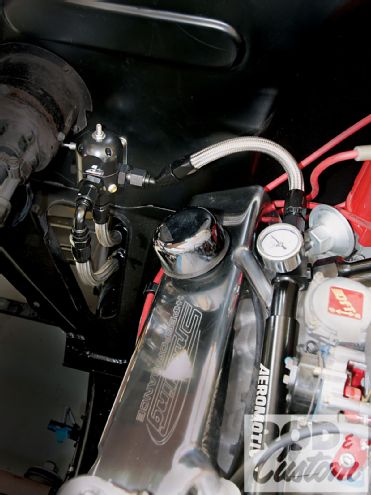
For starters, I needed a complete system, as my stock tank had already been repaired once and no longer had fuel gauge provisions. And, considering how rusty the car was when I bought it, I felt safer replacing the stock fuel lines from front to rear. Seeing as I'd gone a little beyond my original plans with the Smeding 383 stroker motor, I wanted a system that was capable of delivering enough fuel to feed the 400-plus horsepower engine. I also wanted to incorporate a return line should I ever decide to swap out the carburetor for fuel injection. After all, if I'm going to the trouble of fitting a complete fuel system, why not do the job just once, and incorporate the capability to handle whatever may happen in the future? With the Aeromotive system, I'm confident that I'll never run it to its maximum potential of 1,000-plus horsepower capability, but I can also be confident that I won't lean out the motor either, no matter what I do to the engine farther down the road.
However, Aeromotive products are not just for race cars, indeed they offer multiple options for street rods and muscle cars and even a couple of "universal hot rod systems" for late-model EFI or crate engine swaps, with inline pumps, filters, and regulators, as well as Stealth fuel systems. The first type of these uses a fuel pump completely submersed in a baffled fuel tank sump box, which can be welded into almost any existing fuel tank. It is this system our sister magazine STREET RODDER used in their '52 Chevy Road Tour car last year. Aeromotive also offers an aluminum fuel cell in the Stealth series, which again features an in-tank pump. In this case, it's the company's A1000 pump, which is probably their most versatile fuel pump (ideal for 200hp carbureted engines all the way to 1,000hp EFI engines) and claimed to be the most durable of its kind. The Eliminator pump is also available in this cell, though it's bigger and unnecessary for my application, as a smaller pump for lower horsepower applications will be available soon, which will be a non-billet pump more akin to what you'd find in an OEM application.
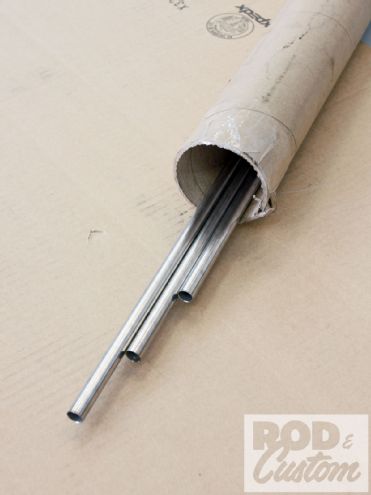 <strong>3</strong> For the hard line I went to Classic Tube, who supplied three 6-foot lengths of 1/2-inch stainless steel tubing. This has an inside diameter of 7/16-inch and accepts AN -8 fittings. Though harder to bend than regular steel lines, stainless can still be bent by hand so long as you have the correct bending tool.
<strong>3</strong> For the hard line I went to Classic Tube, who supplied three 6-foot lengths of 1/2-inch stainless steel tubing. This has an inside diameter of 7/16-inch and accepts AN -8 fittings. Though harder to bend than regular steel lines, stainless can still be bent by hand so long as you have the correct bending tool.
So what's so good about placing the pump inside the fuel tank? Advantages include cooler temps and dramatically reduced pump noise, ideal fuel pump environment, and a reduction in installation time, not to mention the Stealth cells eliminate the risk of fuel pump cavitation, owing to hard cornering, launching, or braking thanks to innovative baffling. There's a reason the OEMs have been using in-tank pumps for a couple of decades! The Stealth cells are compatible with carburetors or EFI, so long as the correct regulator is selected.
For my application, Aeromotive recommended their 13204 Carbureted Bypass Regulator, designed specifically to be used with the A1000 or Eliminator pump in a carbureted application. It is capable of adjusting the base fuel pressure from 3-15 psi, and features an AN-10 inlet port and -8 return port, with two -6 outlet ports and a 1/8-inch NPT gauge port. Pressure isn't provided by the fuel pump, but rather by the regulator restricting the volume flowing through the pump, thereby driving the pressure up to a set point. With a bypass regulator, once the pump has created enough pressure to open the regulator bypass, the regulator leaks just enough flow to maintain the desired pressure. The regulator requires some flow through the unit while pressure is being adjusted, and the correct method to set pressure is with the pump on and the engine running.
It should also be mentioned that Aeromotive offers a fuel pump speed controller. This is mainly required by EFI systems with an inline pump rather than an in-tank version, which can help prevent cavitation and vaporization caused by low pressure in the pre-pump plumbing, caused when the constantly re-circulating fuel becomes hot after running through the engine bay and back to the tank a few times. Given that 8 gallons of fuel will re-circulate every three minutes, you can see how heat can build up. Activated by a signal from the tachometer, the speed controller will reduce pump speed at lower rpm; ramping up to full speed at 2,500 rpm. However, unless the car will sit idling for hours, the controller is not required with a fuel cell system, which eliminates the pre-pump plumbing and associated low-pressure issues.
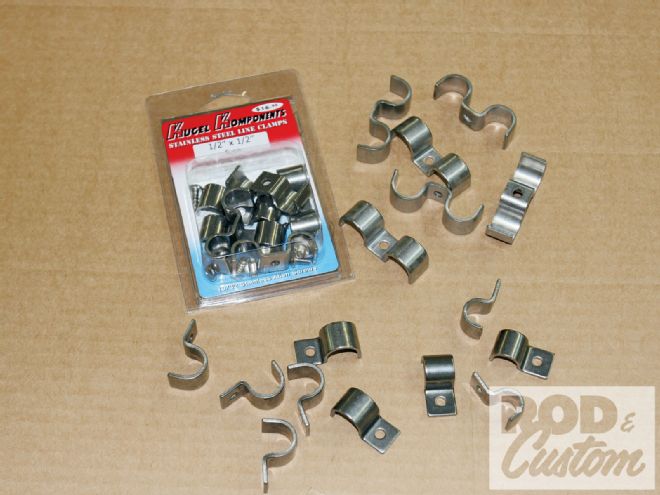 <strong>7</strong> I needed a method of attaching my bent and flared stainless lines to the chassis, and what better than stainless line clamps from Kugel Komponents? Available in a number of different sizes from 3/16 to 7/8 inch, as well as in single or double clamp design, I used 1/2 and 5/8 inch in both single and double variants.
<strong>7</strong> I needed a method of attaching my bent and flared stainless lines to the chassis, and what better than stainless line clamps from Kugel Komponents? Available in a number of different sizes from 3/16 to 7/8 inch, as well as in single or double clamp design, I used 1/2 and 5/8 inch in both single and double variants.
If you're a regular reader you'll already have seen the dropped trunk floor I fabricated to house the fuel cell and RideTech compressor and pump for the air suspension. The remainder of the installation involved drilling holes to route the braided fuel lines through the floor, fabricating a mount for the fuel filter on the righthand chassis rail, and mounting the regulator to the firewall. Actually, there was a little more to it than that, as I chose to run rigid stainless for both the feed and return lines rather than run braided hose front to rear. The hardest part of the install was figuring out the plumbing and the fittings needed, and I resorted to drawing the system out on a large sheet of cardboard to make sure I got it right. This may sound lame, but considering the number of fittings required to switch from braided to hard line, and in and out of the various components, it worked out the best way for me.
I was also trying to figure out how to run the Aeromotive fuel log in a "full-flow" manner, but given its physical size and the location of my A/C compressor, it didn't work out, no matter how I tried. I even ordered special Fragola banjo fittings from Summit Racing in the hope they'd clear the compressor, but to no avail. I eventually resigned to run a semi-"dead head" system, whereby the fuel passes through the regulator to the fuel log, which is blanked off at the forward end, the return line to the tank running back from the regulator. By comparison, the "full-flow" system involves the fuel entering the front of the log, with the regulator actually attached to the rear of the log rather than the firewall, and with the return line again running from the regulator. Speaking to the guys at Aeromotive, though the full-flow system is what they usually recommend, I was assured the alternative was perfectly adequate for a street application. Let's face it, it's what we've all seen many, many times before on street cars with more power than my Chevy, and that's without a return line.
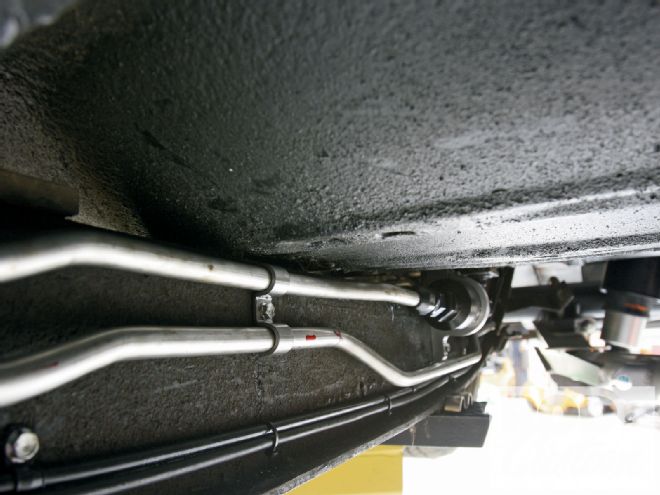 <strong>8</strong> The double 1/2-inch Kugel clamps worked perfectly to attach the hard lines to the framerails. The upper tube is the feed line while the lower is the return.
<strong>8</strong> The double 1/2-inch Kugel clamps worked perfectly to attach the hard lines to the framerails. The upper tube is the feed line while the lower is the return.
Once I got my head around the layout of the system-thanks to my cardboard diagram-and worked out the routing of the hoses and hard lines, the complete system was a breeze to fit and I really liked the simplicity of the pump-in-tank method. Not only does the fuel system look good, I know it'll handle whatever I throw at it in the future, and am excited that the project is one major step closer to completion.